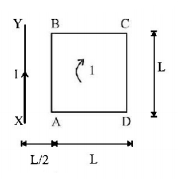131.
A current carrying loop is placed in the non-uniform magnetic field whose variation in space is shown in fig. Direction of magnetic field is into the plane of paper. The magnetic force experienced by the loop is

A
non-zero
B
zero
C
cannot say anything
D
None of the above
Answer :
zero
132. An electron is moving in a circular path under the influence of a transverse magnetic field of $$3.57 \times {10^{ - 2}}T.$$ If the value of $$e/m$$ is $$1.76 \times {10^{11}}C/kg,$$ the frequency of revolution of the electron is
A
$$1\,GHz$$
B
$$100\,MHz$$
C
$$62.8\,MHz$$
D
$$6.28\,MHz$$
Answer :
$$1\,GHz$$
133. A charged particle moves through a magnetic field perpendicular to its direction. Then
A
kinetic energy changes but the momentum is constant
B
the momentum changes but the kinetic energy is constant
C
both momentum and kinetic energy of the particle are not constant
D
both momentum and kinetic energy of the particle are constant
Answer :
the momentum changes but the kinetic energy is constant
134. A charged particle of mass $$m$$ and charge $$q$$ travels on a circular path of radius $$r$$ that is perpendicular to a magnetic field $$B.$$ The time taken by the particle to complete one revolution is
A
$$\frac{{2\pi {q^2}B}}{m}$$
B
$$\frac{{2\pi mq}}{B}$$
C
$$\frac{{2\pi m}}{{qB}}$$
D
$$\frac{{2\pi qB}}{m}$$
Answer :
$$\frac{{2\pi m}}{{qB}}$$
135. A particle of charge $$q$$ and mass $$m$$ starts moving from the origin under the action of an electric field $$\overrightarrow E = {E_0}\hat i$$ and $$\overrightarrow B = {B_0}\hat i$$ with velocity $$\overrightarrow v = {v_0}\hat j.$$ The speed of the particle will become $$2{v_0}$$ after a time
A
$$t = \frac{{2m{v_0}}}{{qE}}$$
B
$$t = \frac{{2Bq}}{{m{v_0}}}$$
C
$$t = \frac{{\sqrt 3 Bq}}{{m{v_0}}}$$
D
$$t = \frac{{\sqrt 3 m{v_0}}}{{qE}}$$
Answer :
136. A galvanometer of resistance $$50\,\Omega $$ is connected to battery of $$3\,V$$ along with a resistance of $$2950\,\Omega $$ in series. A full scale deflection of $$30$$ divisions is obtained in the galvanometer. In order to reduce this deflection to $$20$$ divisions, the resistance in series should be
A
$$5050\,\Omega $$
B
$$5550\,\Omega $$
C
$$6050\,\Omega $$
D
$$4450\,\Omega $$
Answer :
$$4450\,\Omega $$
137. If an electron and a proton having same momenta enter perpendicular to a magnetic field, then
A
curved path of electron and proton will be same (ignoring the sense of revolution)
B
they will move undeflected
C
curved path of electron is more curved than that of the proton
D
path of proton is more curved.
Answer :
curved path of electron and proton will be same (ignoring the sense of revolution)
138.
Consider a hypothetic spherical body. The body is cut into two parts about the diameter. One of hemispherical portion has mass distribution $$m$$ while the other portion has identical charge distribution $$q.$$ The body is rotated about the axis with constant speed $$\omega .$$ Then, the ratio of magnetic moment to angular momentum is

A
$$\frac{q}{{2m}}$$
B
$$ > \frac{q}{{2m}}$$
C
$$ < \frac{q}{{2m}}$$
D
cannot be calculated
Answer :
$$\frac{q}{{2m}}$$
139. A square current carrying loop is suspended in a uniform magnetic field acting in the plane of the loop. If the force on one arm of the loop is $$F,$$ the net force on the remaining three arms of the loop is
A
$$3F$$
B
$$ - F$$
C
$$ - 3F$$
D
$$F$$
Answer :
$$ - F$$
140.
A square loop $$ABCD$$ carrying a current $$i,$$ is placed near and coplanar with a long straight conductor $$XY$$ carrying a current $$I,$$ the net force on the loop will be :

A
$$\frac{{2{\mu _0}Ii}}{{3\pi }}$$
B
$$\frac{{{\mu _0}Ii}}{{2\pi }}$$
C
$$\frac{{2{\mu _0}IiL}}{{3\pi }}$$
D
$$\frac{{{\mu _0}IiL}}{{2\pi }}$$
Answer :
$$\frac{{2{\mu _0}Ii}}{{3\pi }}$$
